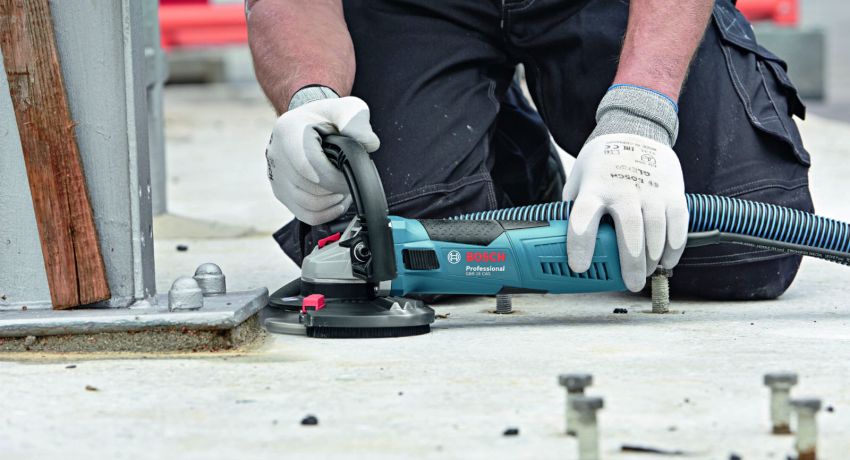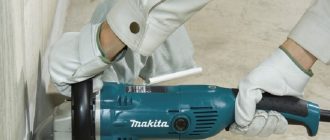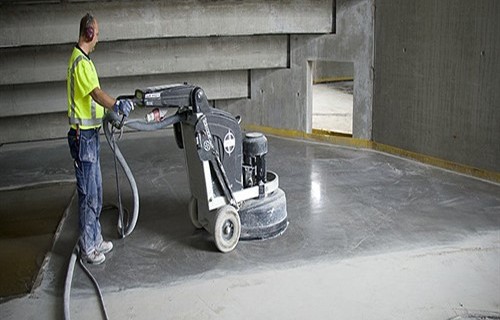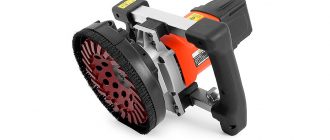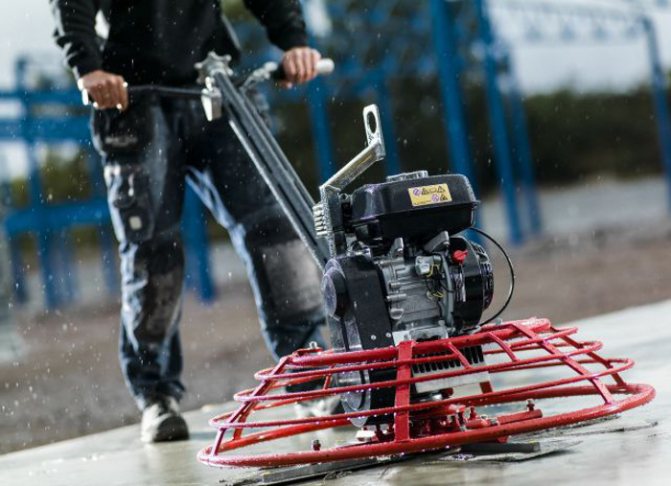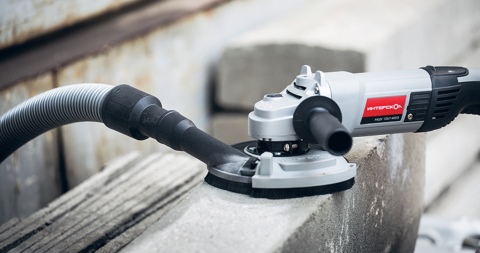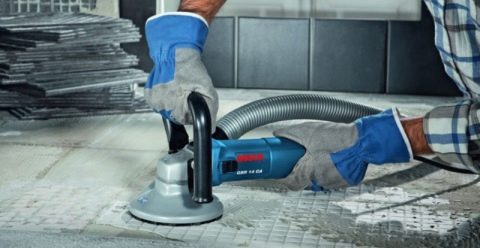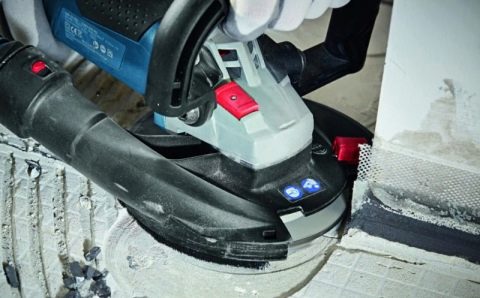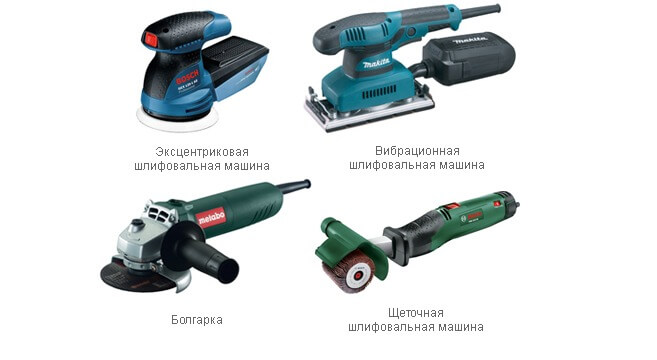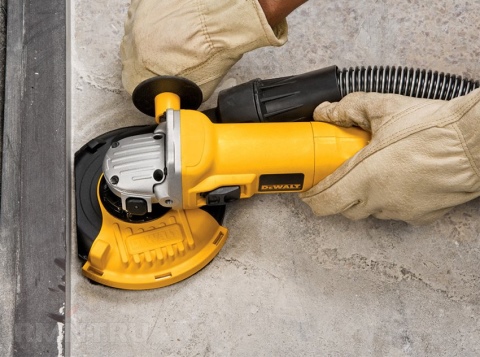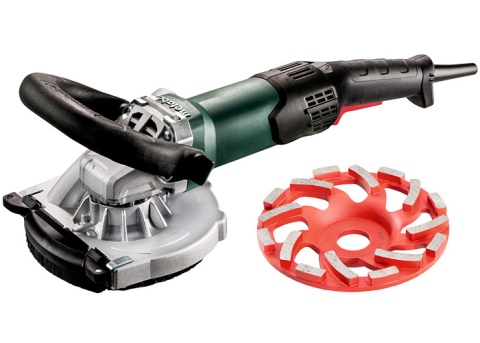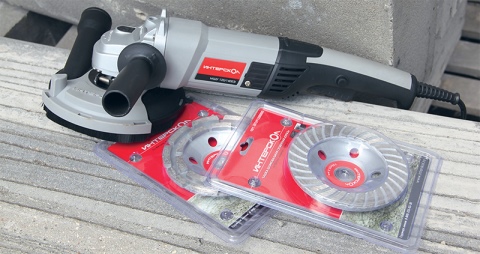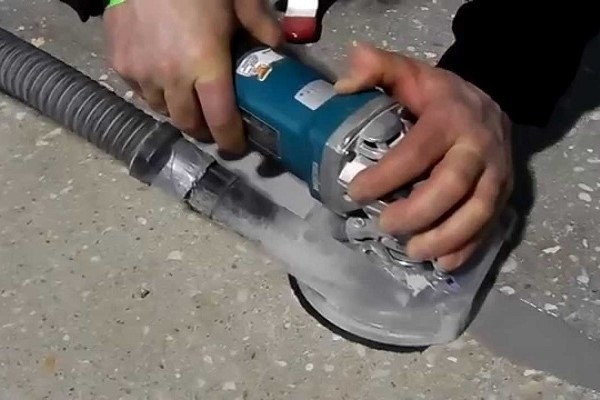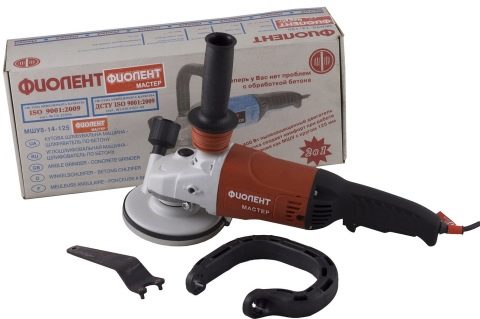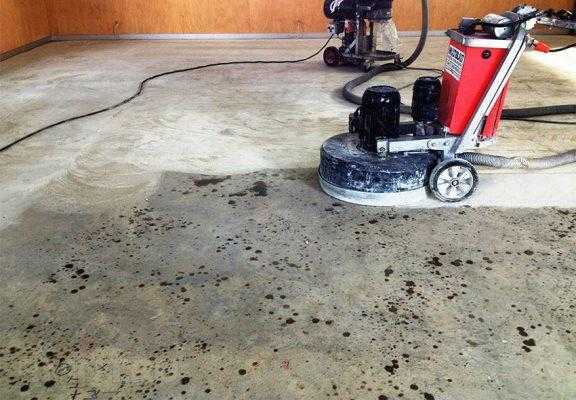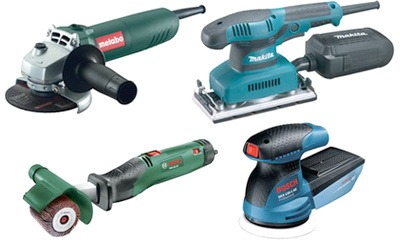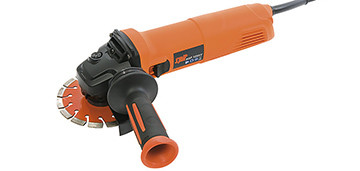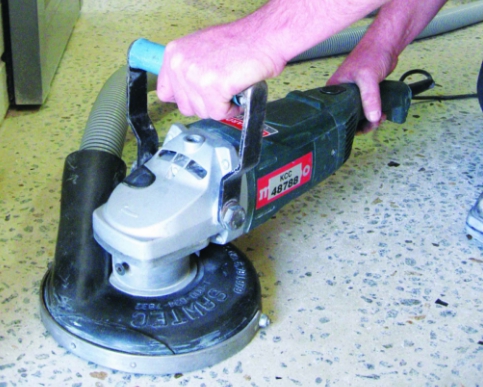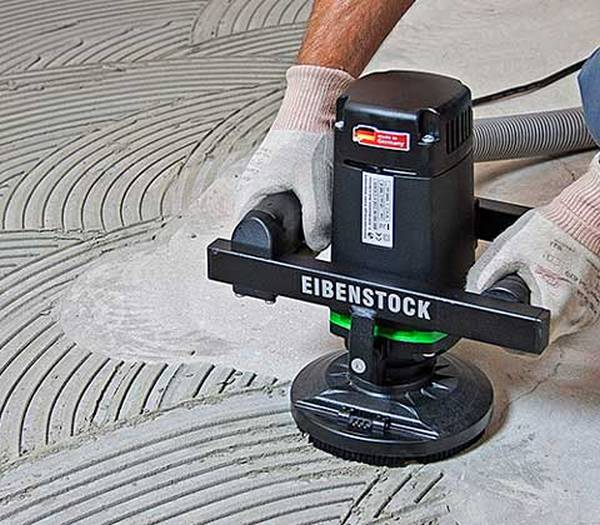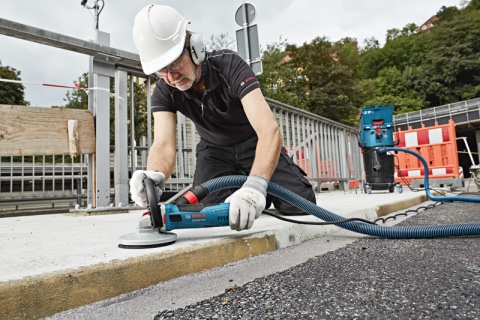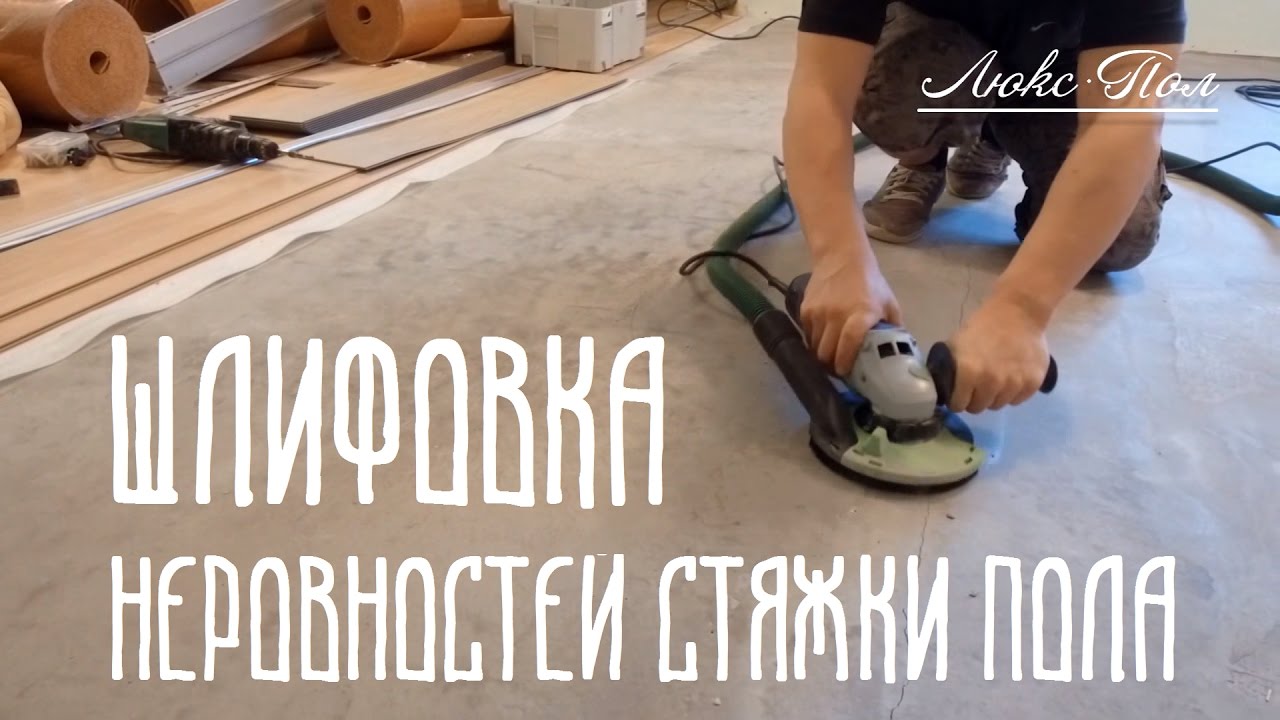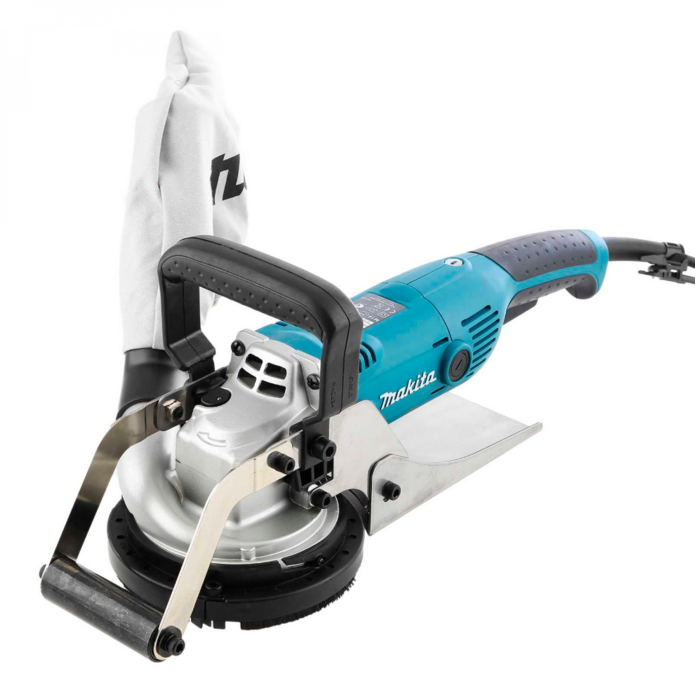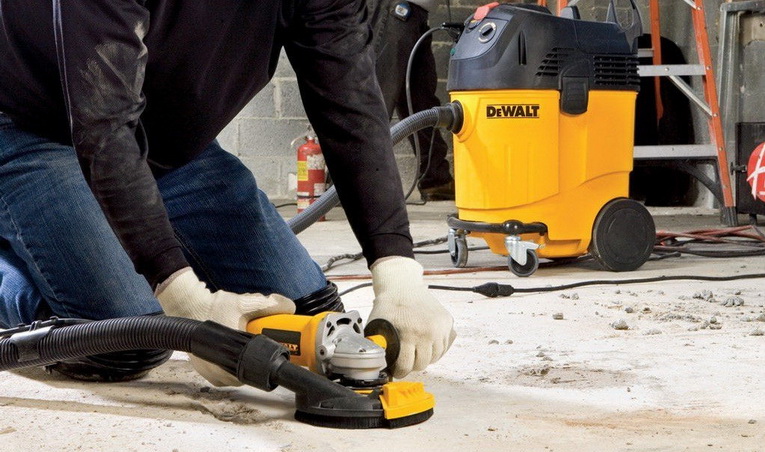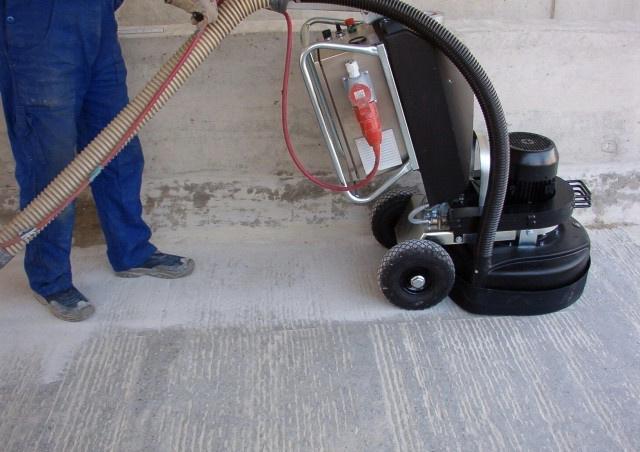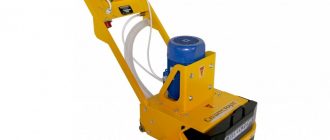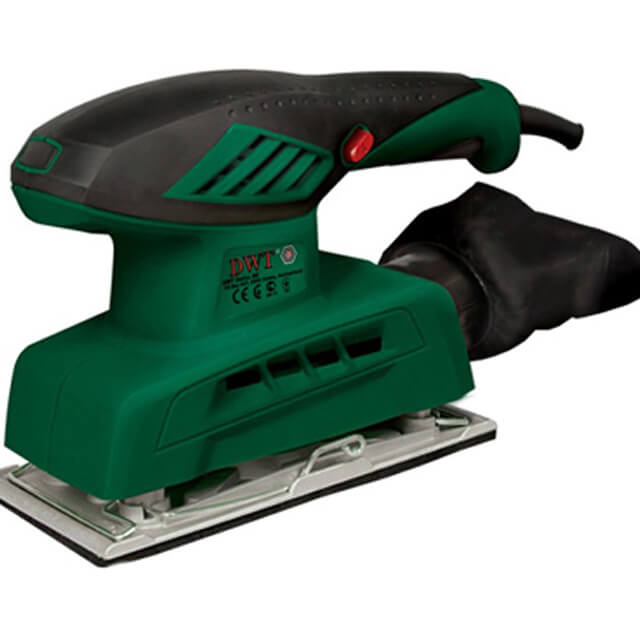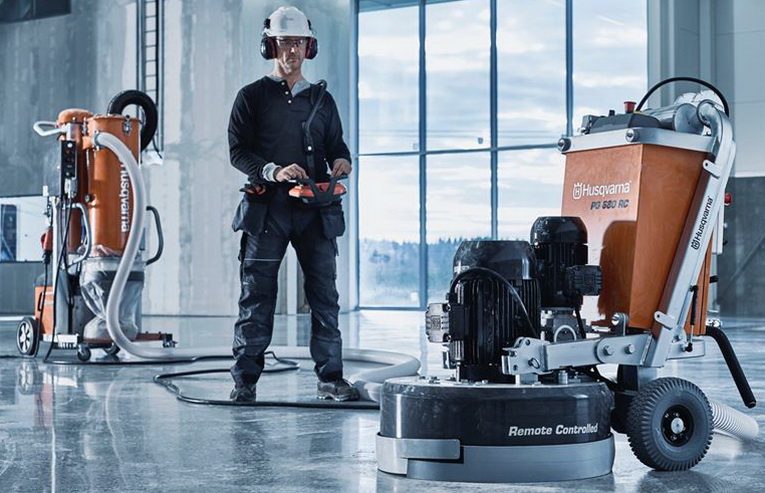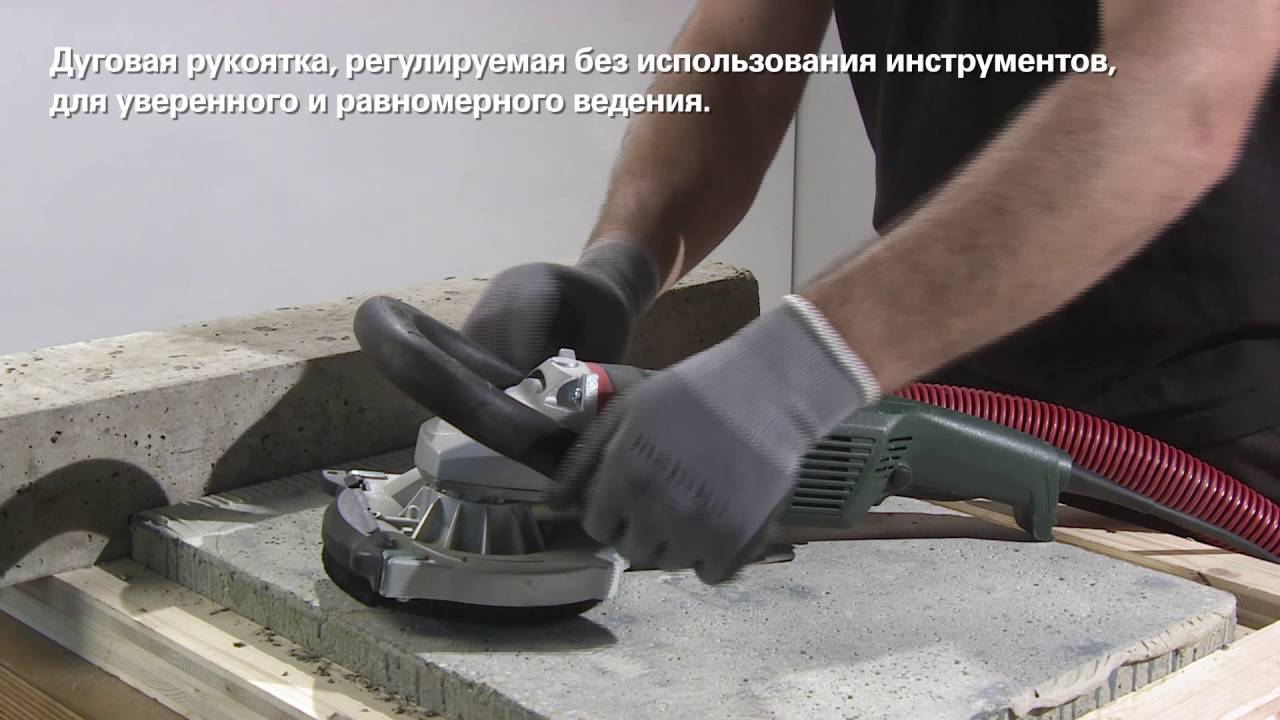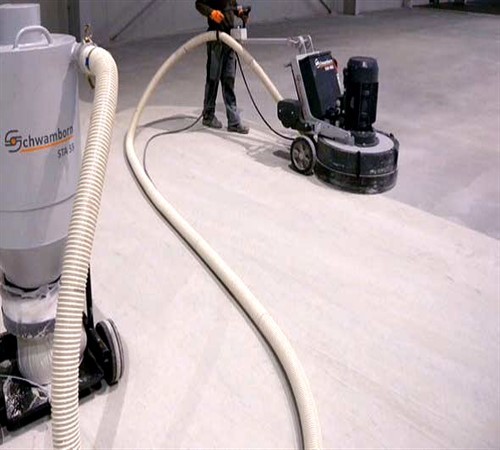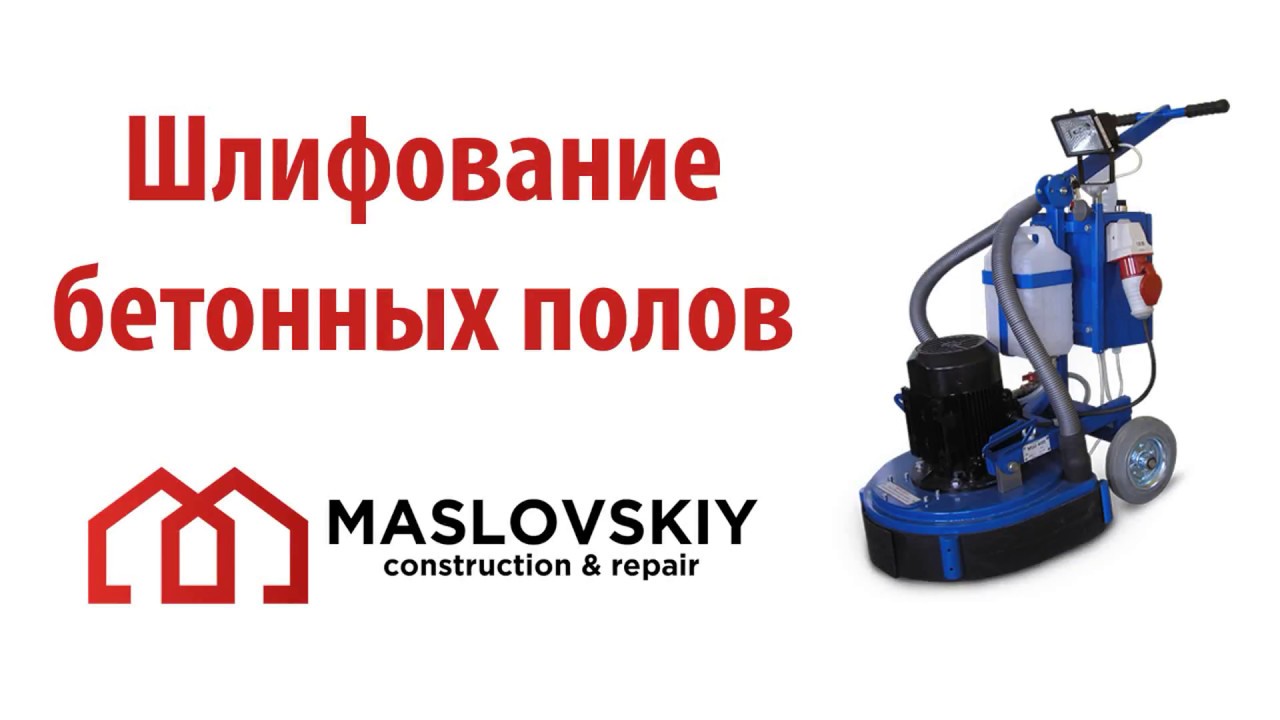Old base processing technology
In the case of repair work that does not involve the installation of a new screed, the floor surface is treated in several stages. Of course, with a large number of caverns and potholes, a screed device is necessary. But in industrial or warehouse premises with a well-made base base, it makes no sense to weight the structure with an additional layer of concrete.
Preparation of the base
The first step is to remove old flooring, various debris and defects. If the top layer of concrete is clearly destroyed, it must be removed with special devices, for example, seam cutting machines.

With a small number of obvious defects, the depth of which exceeds 5 - 7 mm, they must be repaired with special repair compounds. In this case, grinding of the base is possible only after the composites have hardened and have reached about 50% of the design strength.
Removing the top layer of concrete
The second stage of work is rough surface treatment. In this case, grinding the concrete floor is carried out using discs with an abrasive grain of no more than 30 units. Depending on the actual strength of the artificial stone, processing can be carried out with corundum or diamond discs.
It must be remembered that concrete is a material with high strength, therefore, with a design class of more than B15, it is necessary to use diamond-coated discs. For screeds with less strength, less durable and cheaper corundum is suitable.
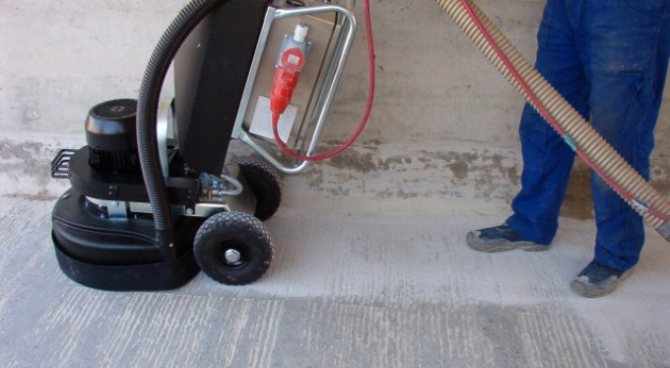
At this stage of work, the largest amount of dust or sludge is formed, so it is worthwhile to take care of airing the room and removing dirt from the floor surface in advance. It should also be remembered that when removing the top layer and cement laitance, you should not remove more than 5 - 7 mm of material. In fact, you only need to expose the coarse aggregate, but keep the concrete layer at least 1.5 cm above the reinforcement to effectively protect the metal frame.
Finishing
After the top layer of concrete is removed, the surface is hardened by means of special mineral composites containing calcium silicates.

After removing dust and sludge, the mineral powder is applied to the surface to be treated and rubbed in with a grinding wheel with an abrasive grain of 40 to 200. If only the floor surface is smoothed, it is better to use discs with diamond grit 40 - 60, and when applying a mineral composite - 80 - 150 units.
Further, processing is carried out with disks with a grit size of diamond chips of 1500 or less. This grout is actually a surface polish. After such treatment, the concrete floor acquires a mirror surface and no longer requires any finishing.
Classification
First of all, all machines are divided into several types in terms of power and dimensions.
Here it is important to understand what volume of work a mosaic grinder is needed for: for repairing a house, a small manual electric model will be enough, for industrial use it is better to choose a powerful gasoline model that looks more like a special vehicle than a tool
Cars by type of interaction with the operator:
- Manual - easily moves on the treated surface, involves a small amount of work. Diamond cutters and abrasive segments can be used, the number of traverses - from one. Single traverse machines are relevant where space is limited. With an increase in the number of traverses, the power parameter of the equipment also increases.The hand tool can be provided with a water tank for wetting the surface to be treated, a shock absorption system to ensure uniform force and smooth operation, a protective casing for safety.
- Self-propelled - a huge variety of modifications, designs and engineering solutions are presented on the market. This is a serious equipment designed to perform an impressive volume of a wide variety of concrete processing jobs. Typically, self-propelled concrete mosaic grinders are equipped with hydraulic or electric drive wheels. The machines can be connected to a water supply system or have a separate water tank, often controlled remotely.
By the principle of action
Different tools are used to treat concrete surfaces. According to the principle of action, there are only two types.
Types of machines according to the principle of operation:
- Planetary - faceplates with rigging are mounted on a disk, all this moves in different directions or in one direction (depending on the desired impact on the monolith). If the movement is unidirectional, then the pressure is small and polishing and final grinding are performed. Reducing resistance means less energy is consumed.
- Traverse - the drivers on which the working tools are mounted, usually rotate in opposite directions, but the traverse itself is stationary. This way it is possible to achieve maximum pressure on the concrete surface, effectively and quickly removing serious drops. Scratches from aggressive effects may appear on the floor, so then finishing is also performed.
By working equipment
Usually used as consumables: polishing wheels, "Frankfurt" and diamond cutters, grinding stones, brushes, "turtles", grinding discs, etc. Carbide tipped bowls are also popular. Cups with diamond segments are resistant to various parts protruding from the concrete floor surface.
By drive type
The drive can be gasoline and electric (diesel is used very rarely).
Features of machines with different drives:
- Gasoline - relevant where there is no access to electricity. Very powerful, suitable for large-scale works, they require a constant supply of fresh air to the object.
- Electric - less powerful, require connection to a network of 220, 380 V. They emit little noise, can be used in closed objects.
The type of mosaic grinder is chosen in accordance with the scale of work, the characteristics of the object, the required power and budget.
Useful functions
Grinding machines can have a wide variety of functions
First of all, they pay attention to the main ones and estimate the scope of work. When implementing different tasks, it makes sense to choose universal units
If you need to perform only one type of work, then the choice is made on the appropriate type of tool.
Various options for mosaic grinders:
- The presence of tool protection - this can be a casing, additional parts
- Connector for simultaneous operation with a vacuum cleaner
- Ability to switch speeds with high precision setting of the current mode
- Sanding at the very edge of the wall
- Speed and ease of replacement of components, their availability
- Foldable handle for easy transport of the tool
- The choice of equipment - the more, the wider the range of operations performed: grinding, polishing, roughening, removing old layers, etc.
Safety engineering
Sanding walls and ceilings is considered the most dusty of all types of renovation work, which is why it is very important to protect your eyes and respiratory system while sanding. To do this, wear protective goggles, as well as a respirator.
It is better to remove all pieces of furniture from the room in advance, and cover the floor with a film - otherwise they will be covered with a dense layer of chalk dust, which will be quite problematic to get rid of.
Be sure to move safely around the room with a working tool in hand. If you are forced to work in low light conditions, there is a risk of injury. Most professional models are equipped with an extended handle, this reduces the risk of falling off stepladders and ladders while working.
Like any other electric construction tool, grinders are a source of sparks, so it is strictly forbidden to grind near flammable objects, liquids and vapors. The sanding process should not be interrupted, therefore, children and pets should be taken out of the room in advance.
If the machine has a ground connection, the use of adapters is unacceptable.
Do not work with the tool with the cover removed.
If any extraneous noise or strong smell appears, immediately turn off the device - it is faulty, and you should contact the service center.
And, of course, give preference to tools from trusted manufacturers. The rating of the most practical and reliable grinders includes Makita, Sturm and Interskol.
In the next video, you will find an overview of the Sturm DWS 6016 wall and ceiling sander.
What are they used for?
Handcrafting stone surfaces is a laborious and time-consuming process that does not always give the desired result. The solution to this problem was the creation of concrete grinders, which are offered in a wide range.
Each grinder has an individual set of functions, which is capable of efficiently and quickly:
- sand the freshly laid cement floor;
- remove the worn-out top layer on old concrete;
- level the surface before final finishing;
- remove hills and smooth out bevels;
- roughen to improve the adhesion of concrete to the finishing material (glue, putty, etc.).
However, like any other technique, grinding machines have their pros and cons. The most significant are listed below.
Application and principle of operation
Grouting of concrete floors by helicopter is used to give concrete the desired properties and characteristics, as well as to eliminate the risk of coating delamination during operation due to the monolith protruding on the surface.
The concrete floor is trowelled in two stages. First, 4-20 hours after pouring, a rough grout is carried out at the moment when the footprint from the shoe in the concrete leaves a depth of up to 3 millimeters. For additional hardening, cement-based toppings are used and the process begins only when the product has absorbed moisture from the floor.
First, the composition is distributed in a uniform layer over the concrete, then about two-thirds of the mass is rubbed into the monolith, after a while another third is rubbed. The unit turns on the blades at a reduced rotation speed and the work is performed in two passes, which must be perpendicular to one another.
Finishing grouting (helicopter) is performed within 10-16 hours after the completion of roughing (the floor should darken, should not get your hands dirty and squeezed through). The machine rub in the dedusting impregnation in one or two layers, after which the concrete becomes stable and not susceptible to crack propagation. The work is carried out with crossing finishing blades, at high speed, in two passes (also perpendicular).
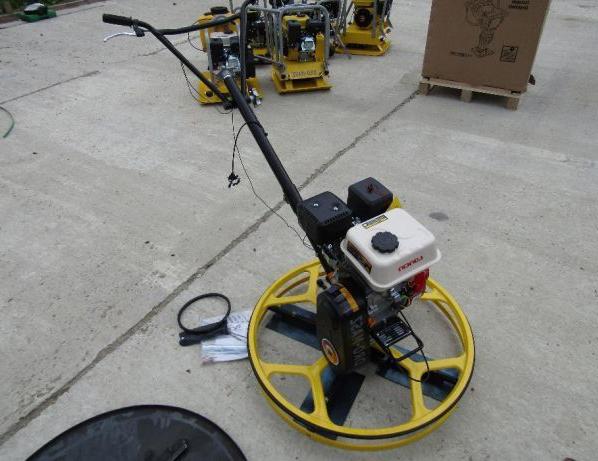
How to grind
Grinding a concrete floor with your own hands using various methods is very similar in the stages of work carried out, only the nuances differ. Therefore, it is best to consider the general essence of the process, adjusted for the subtleties of the work in one way or another.
Preparation
Do-it-yourself concrete grinding begins with a well-prepared surface of the poured base.
If it is necessary to carry out some work, for example, drilling, then they must be done before the moment of grinding, so as not to damage the perfectly flat surface later.
Stage 1.Carefully inspect the finished floor for foreign objects sticking out of it - reinforcement or reinforced mesh. If there are any, it is best to remove them beforehand.
Stage 2. If there are shrinkage and expansion cracks or seams, then they must be repaired. And only after the patches have dried, the concrete floor is processed.
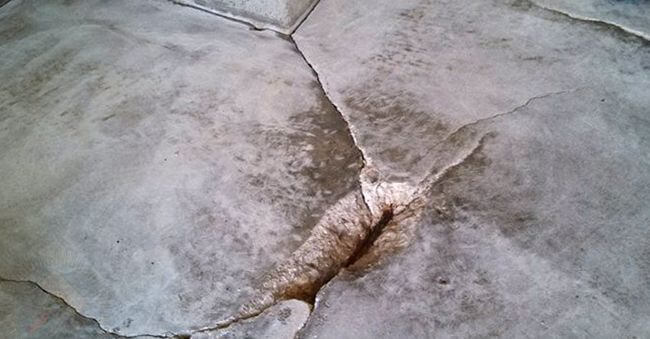
Stage 3. For grinding, a prerequisite is the flatness of the plane, which is determined by a three-dimensional ruler.
Stage 4. It is necessary to start processing the floor only if the concrete is strong enough. To determine this indicator, a basis is tapped over the entire area. If somewhere a section is found that has not gained strength, then it is better to postpone processing, since such an error can lead to a complete replacement of the concrete floor.
Stage 5. In the presence of bumps and pits, to eliminate them, use a nozzle with a higher abrasiveness for roughing.
Stage 6. To determine for yourself the rigidity of a concrete floor, it is best to try to process it with a grinder and see the result.
Grinding process
With any method of grinding, nozzles of various sizes of abrasive are selected, depending on the type of surface to be treated individually. Approximately, to remove the first layer with large potholes, nozzles with a size of 25-30 are used, and for a decorative one - 40. If you use a size greater than 40, you can achieve an incredibly strong and durable coating. To obtain a gloss, the floor is polished with nozzles with an abrasive size of 1500 - 3000.
Stage 1. Before starting work, the surface is treated with special impregnations and solutions that strengthen it.
Stage 2. If you have purchased a special grinding unit, then before using it, read the instructions, and best of all, watch the video review on the Internet.
Stage 3. Now you need to grind the hardened concrete floor to the desired smoothness. If you decide on the wet method, then the coating is poured abundantly from the hose in advance. The elimination of liquid occurs by the grinding machine itself.
Stage 4. If it was not possible to process the surface in hard-to-reach places, use a grinder.
Step 5. Upon completion of the work, the concrete floor can be coated with optional paint and polyurethane varnish in several layers. Before applying them, you must thoroughly clean the floor from dust and dirt. Then varnish in several layers. It is applied quite simply with a special brush. After the layer has dried, you can safely use the new floor.
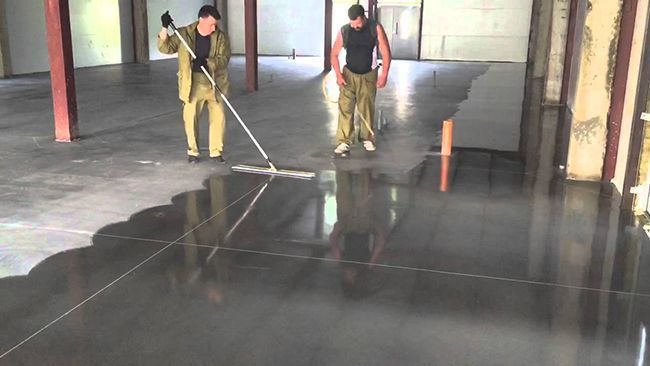
Precautions when working with a grinder
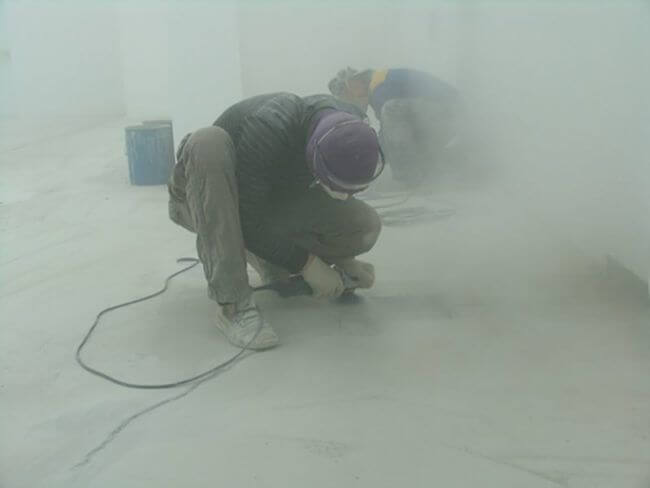
Grinding a concrete floor with a grinder is no different from the stages of work with special machines. Working on them is quite safe and simple, which cannot be said about grinding with a grinder.
To avoid unpleasant situations, be sure to follow these precautions:
- inspect the manual sander for problems;
- take care of good lighting of the workplace;
- it is necessary to carry out grinding work only in tight clothing that covers the whole body, while so that it does not fall on the working surface of the grinder. Don't forget a respirator, goggles and heavy gloves if desired;
- do not overheat the instrument. The maximum cycle of work is 15 minutes. After that, it is imperative to give the instrument a "respite".
Grinding the floor surface, due to its large area, is quite simple and quick. The main thing in carrying out such work is accuracy and care. If you have any questions about how to grind a concrete floor, watch the attached video.

